Text


Update on the enclosure WIP! I haven't really been motivated to work on it but I wanted to get it at least mostly done before it cooled down so Nova could check it out.
It's still nowhere near complete. I want to get a hide or two for each side, cover one side to create a shady area for hot days, and get more climbing stuff, maybe even some live plants. I did find a cool branch though and propped it up with pavers and brick to create a basking spot and something to climb.
I let Nova check out my progress and she seemed satisfied, immediately jumping onto the brick. I've going to see if I can make a 3d background-like thing for one of the walls at least, like what she has inside. This girl wants to live above the ground lol.
Here's a game, spot the Nova in image 1. Each 'spot the lizard' issue will get more difficult as I add things to the enclosure.
10 notes
·
View notes
Text

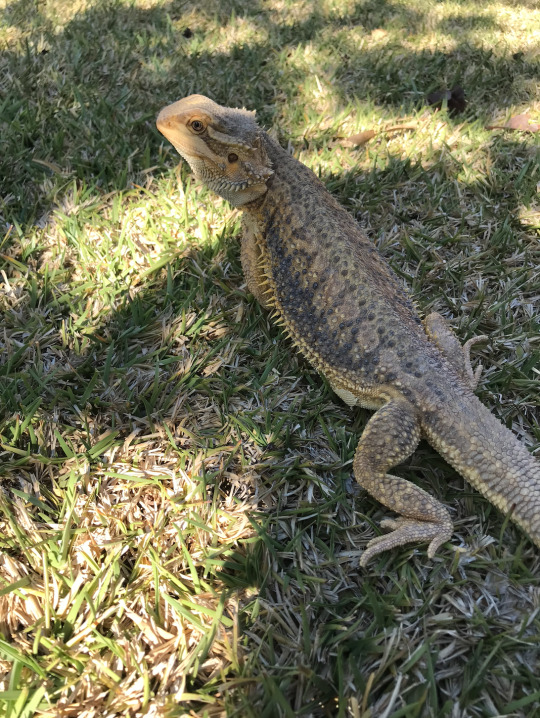
Sorry about the inactivity. I was going through a depressive episode and then my dog passed away so I have been taking time to recover.
I am working on a full Central Bearded Dragon (Pogona vitticeps) husbandry guide + a little infographic. For now, please enjoy some photos of my girl Nova exploring outside!
Note: If you're wondering why she looks underweight in these photos, it's because these are old photos taken while she was underweight due to a parasitic infection (she was from a crappy seller and got pinworms). She has gained weight since then.
1 note
·
View note
Note
Really well put.
I definitely did not agree with a lot of Brian's care standards and breeding practices (specifically regarding spider ball pythons) and I never kept up with his channel, but I can't deny the impact he's had on the community, and while he did a lot, and I mean a lot wrong, he clearly had a genuine passion for and love for these animals.
Pancreatic cancer is such a horrible way to go. I would not wish it upon my worst enemy. Terminal illness is probably one of biggest fears - knowing death is fast approaching, slowly deteriorating and not being able to do anything. It's a terrifying disease and I have a lot of sympathy for people who have suffered it, including Brian.
While I did not agree with Brian Barczyk, I hope he was as comfortable as possible (considering everything), and it's definitely a huge loss. He was not old enough to die, and did not deserve death to such a horrible cause.
RIP Brian Barczyk.
Brian Barczyk, keeper of giant snakes in tiny drawers, has died. How should we feel?
I've been asking myself this very question, anon.
On one hand, the man did some really unethical stuff, pushed harmful information that was not correct husbandry, and allowed animals to suffer for his own gain.
On the other hand, he was human, as we all are human: prone to failings, easily blinded by praise, and willing to hide his mistakes in order to maintain a positive reputation among his peers. This is really common among that generation. I see the same attitudes in many big-name reptile keepers, TV personalities, and minor celebrities.
He was curious. He was passionate. He wanted to share his passion with others. I think he really truly did love his animals and the people around him, though that love was not an adequate replacement for proper care. He was arrogant. He was overconfident. He was flawed. But he was human.
He was afraid, at the end. He was in pain. Pancreatic cancer is not a gentle end. He saw his death looming on a fast-approaching horizon, and you could see it reflected in his eyes. Did he have regrets, do you suppose? Would he have done things differently if he had another chance? Did he believe in an afterlife, and did he feel the burden of his transgressions as he prepared to meet his gods?
I can tell you how I feel at this point:
A little sad that a fellow traveler on this Earth died in such an awful, painful way. A little disappointed that he's now a martyr of reptile keeping. A little grateful that he helped to push the hobby into the public eye and out of the fringes. A little hopeful that we'll continue to learn, grow, and do better than he did.
I can't tell you how to feel, though, or whether to feel anything at all. That's up to you.
Regardless, I hope his last moments were peaceful, that he felt loved instead of scared, and that he was not in pain. That's what I want for everyone.
#reptiblr#reptiles#text post#tw death mention#cw death mention#death mention#brian barczyk#fuck cancer
172 notes
·
View notes
Text
This is so important to be aware of! Gators (and all crocodilians) are such amazing, unique creatures, and so many fail to read their behaviour properly and just stress them out, specifically on social media (I don't know anyone who owns crocodilians irl).
It's likely unintentional, but so many reptiles, especially the large monitors and crocodilians such as gators, are mistreated on social media.
Alligator Body Language and You, or: How To Know When An Alligator On Social Media is Being Stressed for Views
Alligators are wild animals. Despite the idiotic claims of animal abusers like Jay Brewer, they cannot be domesticated, which means they are always going to react on the same natural instincts they've had for millions of years. Habituated, yes. Tamed, yes. Trained, definitely. Crocodilians can form bonds with people- they're social and quite intelligent. They can solve problems, use tools, and they're actually quite playful. Alligators are also really good at communicating how they're feeling, but to somebody who doesn't spend much time around them, their body language can be a bit mystifying. And it doesn't help when social media influencers are saying shit like this:

That is not what a happy gator looks like.
That's a terrified, furious gator who isn't attacking because the ogre handling her has her in a chokehold. She's doing everything she can to express her displeasure, and he's lying about it because he knows his audience doesn't even know how to think critically about what he's doing. He knows that because his audience doesn't know anything about these animals, he can get away with it. This I think is why I hate him so much- he deliberately miseducates his audience. He knows what he's doing is factually inaccurate, he just doesn't care because attention means more to him than anything else in the world.
Let's change that! Here are two really important lessons for understanding alligator body language on social media.
Lesson 1: Alligators Don't Smile (in fact, most animals don't)
So what's going on in this video? Jay Brewer is aggressively choking his white alligator Coconut while scrubbing algae off of her with a toothbrush. And make no mistake, he is digging into the creature's throat while she is visibly distressed. He claims she's happy- but she's not. He is willfully misrepresenting what this animal is feeling. That's a problem, because people... well, we actually kind of suck at reading other species' body language. The reason for this is that we tend to overlay our own responses on their physical cues, and that's a problem. For example, let's look at an animal with a really similar face to ours, the chimpanzee. Check out Ama's toothy grin!
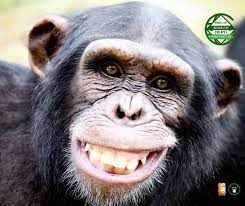
Wait, no. That's not a happy smile. That's a threat display. When a chimpanzee "smiles," it's either terrified and doing a fear grimace, or it's showing you its teeth because it intends on using them in your face.
How about a dog? Look at my smiling, happy puppy!

Oh wait no, this is a picture of Ryder when he was super overwhelmed by noise and people during a holiday party. He'd hopped up in my sister's lap to get away from stuff that was happening on the floor and was panting quite heavily. See the tension in the corners of his mouth and his eyes? A lot of the time when a dog "smiles," the smile isn't happy. It's stress! Why Animals Do The Thing has a nice writeup about that, but the point is, our body language is not the same as other species. And for reptiles, body language is wildly different.
For instance, look at these two alligators. Pretty cute, right? Look at 'em, they're posing for a Christmas card or something! How do you think they're feeling?

Well, I'll tell you how the normal one is feeling. He's annoyed! Why is he annoyed? Because the albino just rolled up, pushed another gator off the platform, and is trying to push this guy, too. I know this because I actually saw it happen. It was pretty funny, not gonna lie. He's not gaping all the way, but he was hissing- you can actually see him getting annoyed in the sequence I took right before this shot. Look at him in this first shot here- he's just relaxing, and you can see he isn't gaping even a little bit.


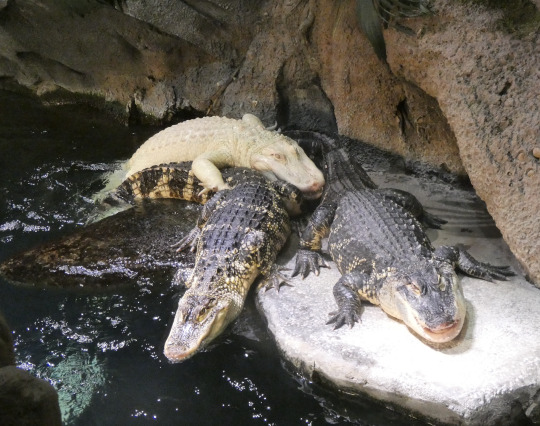
By the end, he's expressing displeasure, but not enough to actually do anything about it. He's annoyed, but he's comfy and that's where one of the best basking areas is, so he'll put up with it.
Reptiles open their mouths wide for a lot of reasons, but never because they are actively enjoying a sensation. Unless they're eating. No reptile smiles- they can't. They don't even have moveable lips. If a reptile is gaping, it's doing so because:
It is doing a threat display.
It is making certain vocalizations, all of which are threats. Alligators are one of the rare reptiles that do regularly vocalize, but most of their calls aren't made with a wide open mouth.
It is about to bite something delicious or somebody stupid. Check out this video- virtually all of the gaping here is anticipatory because these trained gators know darn well that the bowl is full of delicious snacks. (I have some issues with Florida's Wildest, but the man knows how to train a gator AND he is honest about explaining what they're doing and why, and all of his animals are healthy and well-cared for, and he doesn't put the public or his staff at risk- just himself.)
youtube
It's too hot and it has opened its mouth to vent some of that heat and thermoregulate. This is the main reason why alligators will often have their mouths part of the way open, but sometimes they'll open all the way for thermoregulation. This is what a thermoregulatory gape looks like- usually it's not all the way open, kinda more like < rather than V, but you can't say that 100% of the time. Additionally, a thermoregulatory gape... typically happens when it's hot out. If they're inside, maybe they've been under their basking light for too long. Heat's the dominant factor, is what I'm getting at.
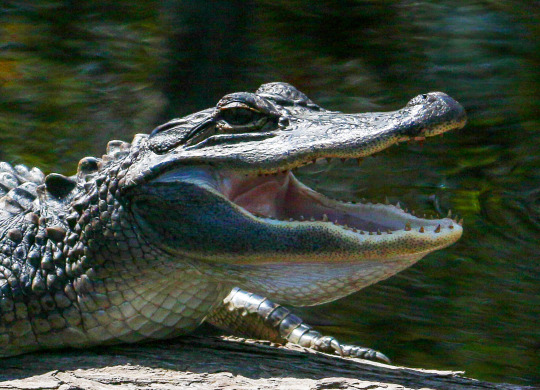
There is another reason that a captive crocodilian might be gaping, and that's because it's doing so on command. Some places have their gators trained to gape on cue, like St. Augustine Alligator Farm and other good zoos. They have the animals do this in presentations that are genuinely educational. They ask the animals to open their mouths so that they can show off their teeth and demonstrate how their tongues seal off the back of their mouth. They'll also do it as part of routine healthcare, because looking at their teeth is important.
In this case, the animals aren't gaping because they're stressed, they're gaping because they know they're gonna get a piece of chicken or fish if they do it. And what's more, they're doing it on cue. They have a specific command or signal that tells them to open wide. It's not an instinctive response to a situation. It's trained. If the animal provides the behavior after a cue, the situation is much less likely to be negatively impactful.
It's also important to remember that there's a difference between a partially open mouth and a gape! As discussed above, alligators will often have their mouths a little bit open just to maintain temperature homeostasis. It helps them stay comfy, temperature-wise. These guys are all doing thermoregulatory open-mouthed behavior- that slight open and relaxed body posture is a dead giveaway. (That and it's the hottest spot in the enclosure.)
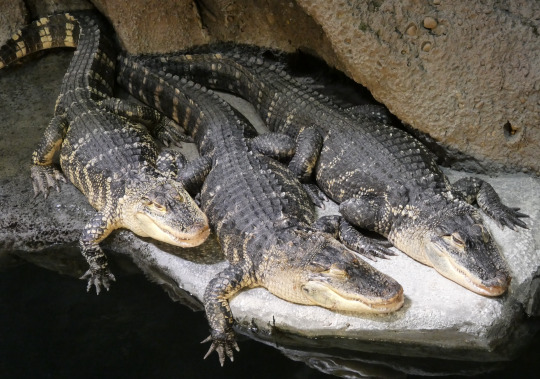
Lesson 2: A Happy Gator Is A Chill Gator
So if alligators don't smile or have facial expressions other than the :V that typically signifies distress, how else can you tell how they're feeling? One way is stillness. See, alligators subscribe to the philosophy of if it sucks... hit da bricks.
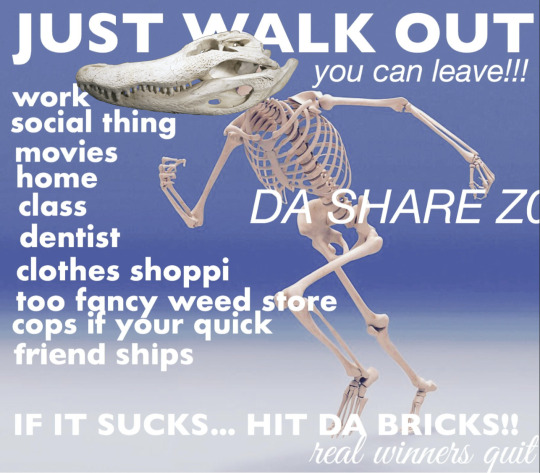
Basically, if they hate it, they'll leave. Unless, y'know, somebody has their meaty claws digging into their throat or is otherwise restraining them. (Restraint isn't always bad, btw. Sometimes the animal is going through a medical thing or needs to be restrained for their safety- which a responsible educator will explain.)
Let's look at a very similar scenario, in which a captive alligator is getting his back scrubbed.
As you can see, it's quite different. First, he's not being restrained at all. Second, look at how relaxed he is! He's just chilling there vibing! He could simply get up and leave if he wanted to, because he's not being held. Towards the end of the video, as he lifts his head, you can see that his respiratory rate is very even as his throat flutters a bit. I'm not sure what this facility is, so I can't comment on care/general ethics, but like. In this specific case, this is an alligator enjoying being scrubbed! And you can tell because he's not doing anything. A happy gator is content to be doing what they're doing.
Why Should I Listen To You?
Now, you should ask yourself, why should you listen to me? Why should you trust me, who does not own an alligator, versus Jay Brewer, who owns several?
Well, first off, there's no profit for me in telling you that what you're seeing on social media is in fact not what you're being told you're seeing. I'm not getting paid to do this. That's the thing with people who make social media content. The big names aren't doing it just for fun. They're doing it for money. Whether that's profit through partnerships or sponsorships, or getting more people to visit their facilities, or ad revenue, you can't ignore the factor of money. And this is NOT a bad thing, because it allows educators to do what they're passionate about! People deserve to be paid for the work that they do!
But the problem starts when you chase the algorithm instead of actually educating. A "smiling" alligator gets the views, and if people don't know enough to know better, it keeps getting the views. People love unconventional animal stories and they want those animals to be happy- but the inability to even know where to start with critically evaluating these posts really hinders the ability to spread real information. Like, this post will probably get a couple hundred notes, but that video of Coconut being scrubbed had almost 400,000 likes when I took that screenshot. Think about how many eyeballs that's reached by now. What I'm saying here is that it's just... really important to think critically about who you're getting your information from. What do dissenters say in the comments? What do other professionals say? You won't find a single herpetologist that has anything good to say about Prehistoric Pets, I can tell you that right now.
Another reason you can trust me is that my sources are not "just trust me bro," or "years of experience pretending my pet shop where animals come to die is a real zoo." Instead, here are my primary sources for my information on alligator behavior:
Dragon Songs: Love and Adventure among Crocodiles, Alligators, and Other Dinosaur Relations- Vladimir Dinets
The Secret Social Lives of Reptiles- J. Sean Doody, Vladimir Dinets, Gordon M. Burghardt
Social Behavior Deficiencies in Captive American Alligators (Alligator mississippiensis)- Z Walsh, H Olson, M Clendening, A Rycyk
Social Displays of the American Alligator (Alligator mississippiensis)- Kent Vliet
Social Signals and Behaviors of Adult Alligators and Crocodiles- Leslie Garrick, Jeffery Lang
Never smile at a crocodile: Gaping behaviour in the Nile crocodile at Ndumo Game Reserve, South Africa- Cormac Price, Mohamed Ezat, Céline Hanzen, Colleen Downs (this one's Nile crocs, not American alligators, but it's really useful for modeling an understanding of gape behaviors and proximity)
Thermoregulatory Behavior of Captive American Alligators (Alligator mississippiensis)- Cheryl S. Asa, Gary D. London, Ronald R. Goellner, Norman Haskell, Glenn Roberts, Crispen Wilson
Unprovoked Mouth Gaping Behavior in Extant Crocodylia- Noah J. Carl, Heather A. Stewart, Jenny S. Paul
Thank you for reading! Here's a very happy wild alligator from Sanibel for your trouble.

33K notes
·
View notes
Text

Image Credits:
"Which beardie do you think is the ideal size?", Avian and Exotic Animal Hospital of Georgia
"After some radiographs we determined that all that was wrong with her was that she was obese and gassy", Jenny J Juniper
0 notes
Text
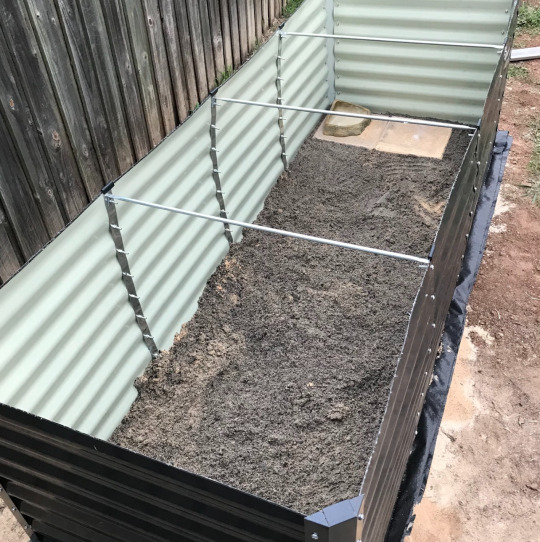
Outdoor enclosure WIP!
It gets very hot during Summer, so I thought Nova would appreciate the natural UVB and warmth. I still need a lid and some stuff to put in the enclosure (hides, climbing stuff, etc), also I'm not sure how I feel about the second paver (next to the water bowl) so may end up taking that out, but here it is so far!
It's about 230 cm long x 80 cm wide x 60 cm tall.
For those who use the imperial measurement system, that's about 7 ft, 6 inches long x 2 ft, 7.5 inches wide x 2 ft tall.
The substrate is a 50/50 mix of washed playsand and organic (fertiliser-free) topsoil.
Nova will be living in the outdoor enclosure only during Summer and probably part of Spring, I won't be leaving her outside year-round.
Anyone who keeps their reptiles in outdoor enclosures, feel free to comment with any recommendations.
0 notes
Text

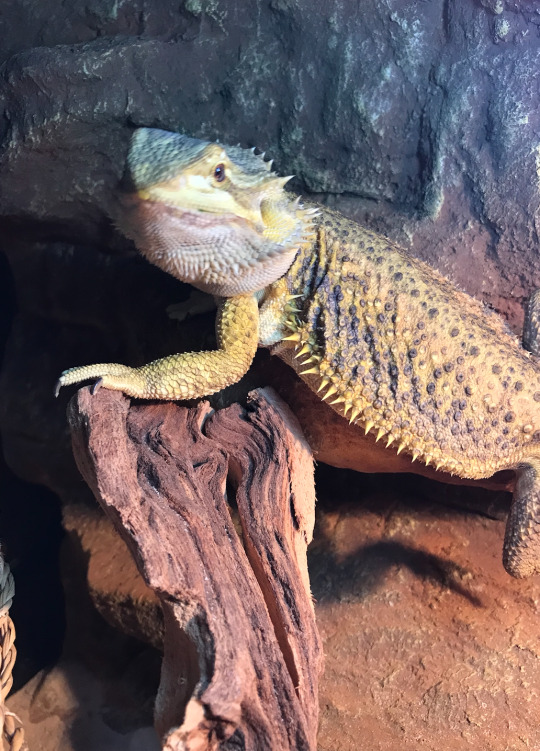
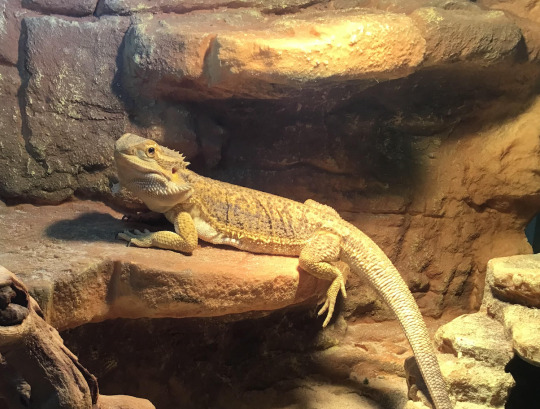
Nova on her rock wall!
She loves climbing it all the way to the top. I strongly recommend a 3D background if possible.
25 notes
·
View notes
Text

#reptiblr#reptiles#snake#corn snake#Pantherophis guttatus#corn snake morphs#red factor corn snake#so pretty!!#just a lil guy
49 notes
·
View notes
Text
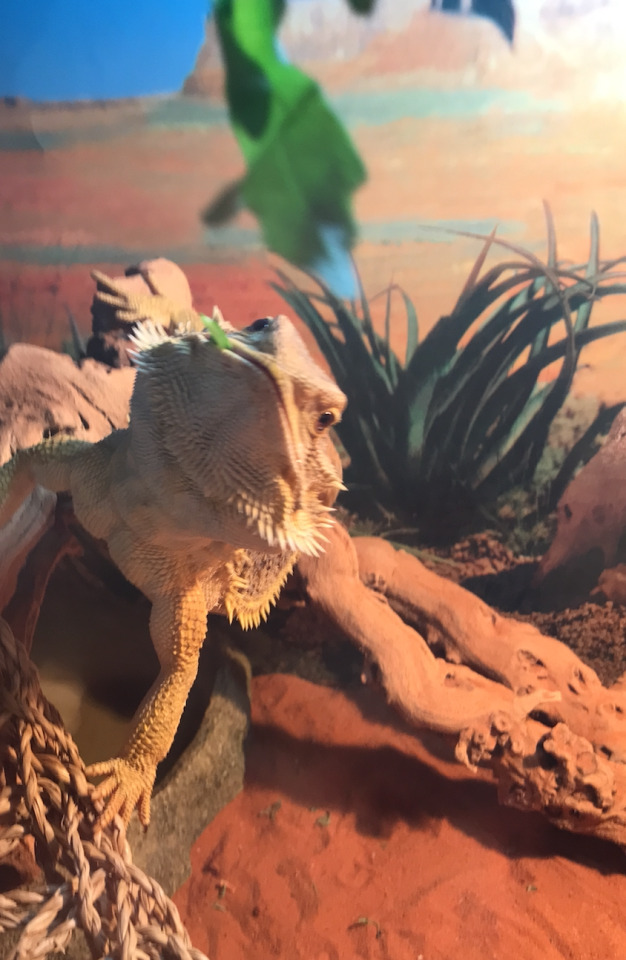
Still laughing at this photo of Nova I took a while back. She loves rocket (arugula). Lol.
Also please excuse the weird red sand, unfilled water bowl and dried leaves. This image was taken before I cleaned and I have since changed the substrate to a playsand/dirt mix.
1 note
·
View note
Text
Environmental Enrichment For Reptiles ; What? Why? and How...?
Environmental enrichment (EE) for animals in captivity is not a new concept, and the benefits of EE on an animals psychological and physiological well being is well documented. However, less attention seems to have been given to reptiles and amphibians. The aim of this post, Is to address the following;
1) What is enrichment?
2) Why is enrichment important? Why have reptiles been overlooked for so long? and what the beneficial effects of EE on reptiles?
a)Improved neural development and cognitive functions
b)Increased activity levels
c)Reduced stress and stress susceptibility
d)Promoting immune health and disease resistance
3) And finally, Some ideas and examples for how you can provide enrichment for your reptile in captivity!

-A Komodo Dragon with a feeding ball at London Zoo by Nigel Sutton
Updated 06/01/2016
Keep reading
3K notes
·
View notes
Photo
The fact that the accepted bare minimums for most snake species, even in 2024, still don't allow for some snakes to even fully stretch their spines.. Do better.

So… whenever I go to a vet office, there’s all these diagrams on pet obesity….. But they never have anything besides cats and dogs. How discriminatory…..
Let’s change that.
Obesity in snakes is so common that it’s literally the default.
In a healthy animals, fat deposits should only be found in the back 1/3rd of the body. As the snake gets fatter, the fat deposits start to develop towards the head.
In extremely obese animals, you’ll start to see fat above the heart, in the throat area.
In morbidly obese snakes, the animal runs out of room and starts to put fat under the skin, giving the snake a soft feel and sausage-y look.
**This Honduran milksnake came from a rescue in the Bay Area. Thank you so much for donating your deceased animals to make these images possible.
Other places to see my anatomy stuff:
INSTAGRAM / FACEBOOK / ETSY
4K notes
·
View notes
Text
About
Hello and welcome!
I have created this blog to discuss all matters reptile - from reptiles in the wild, to captive reptile welfare and care. Reptiles and animal welfare are passions of mine and I want to be able to spread awareness, educate and just share my reptile friends!
I may share a lot of care guides and resources, as well as opinionated content, news, etc. If you want some light-hearted silly content, check out my side blog, @water-dragon-wednesday. Every wednesday, I try to post little pics of the water dragons I see where I volunteer.
---------------
DNI:
Transphobes (including TERFs)
Homophobes
Really just any LGBT-phobic people (including aphobia, etc)
Racists
Zoophiles
Supporters of incest and/or pedophilic ("MAP") relationships
---------------
Featured Tags:
#herp studies - Interesting scientific studies and papers relating to reptiles.
#news - Important events in the reptile community.
#resources - Reptile guides NOT written by me, as well as other cool resources (such as diagrams, etc).
#reptiles 101 - A collection of reptile guides written by me. Please do not use my guides as your only source of info.
#reptile welfare - Discussions relating to reptile welfare, especially neglect and abuse in the reptile keeping hobby (intentional and unintentional).
#Nova - My current beardie, my scaly child, Nova.
#Sidney - My first beardie, the little guy who started it all, Sidney.
#art - Reptile-related art, made by me with the exception of reblogs.
---------------
This page will be updated as this blog grows.
3 notes
·
View notes